February 2004
Trading Tip:
Elliott Wave Theory
by Howard Arrington
The theory is named after Ralph Elliott who observed and
identified repetitive patterns in the stock market and in
nature. He believed all human activities were influenced by
these identifiable wave series. He published several
articles in 1939 in the 'Financial World' magazine.
After his death, others such as Hamilton Bolton (1960) and Robert
Prechter (1978) advanced Elliott's work through books and
newsletters.
Underlying forces in the market are constantly contending in a
kind of tug-of-war. Every move or thrust is followed by a
corrective response. This creates the basic concepts of the
Elliott Wave Theory:
- Action is followed by reaction. Ie. a trend is
followed by a retracement.
- The main trend will contain 5 waves, followed by three
corrective waves.
- This 5-wave and 3-wave cycles are two legs of the next higher
order wave.
For the sake of illustration, a trend or thrust will be indicated
by the letter 'T', and a corrective reaction or retracement by the
letter 'R'. The 5 waves in the main trend wave would be
the represented by T-R-T-R-T. Thus the main trend is
made up of 3 T-waves and 2 R-waves. The convention is to
label these 5 waves with the numbers 1, 2, 3,
4, and 5.
The 3 waves in a correction or retracement would be the
pattern T-R-T and labeled on the chart with the lower case
letters a, b, and c. The correction is
always a move in a direction opposite the 1-5 move's direction.
Elliott Wave Theory says that each wave within a wave contains a
5-3 wave count of a smaller cycle. Thus, in a big T wave will
be found 5 smaller waves in the T-R-T-R-T pattern. And
in the big R wave which is the reaction to the big T wave will be
found the 3 smaller waves in the T-R-T pattern.

Elliott Wave practitioners seek to predict the future by
determining where the market is in the unfolding wave
pattern. They often use Fibonacci
price and time relationships found in the wave formations to predict
both the time and price of future wave completions. The
primary weakness of Elliott Wave Theory is the determination of the
wave count. When the market creates a wave pattern that is at
odds with the current wave count, practitioners reevaluate their
wave counts and relabel the waves.
Trading Tip:
Elliott Wave Application
by Mary
Yvy
What is Elliott Wave? Elliott Wave is a
pattern. Nothing more, nothing less. It has rules, as
any pattern has. Those rules are also related to the Fibonacci
proportions.
Rules: Markets move in Impulsive mode and Corrective
mode. Impulsive mode has 5 waves: 1, 2,
3, 4, 5. The 5 waves in Impulse mode
should not overlap. Non-overlapping waves should be labeled
with numbers as shown below. A characteristic of impulsive
mode is the non-overlapping waves, as in this drawing where the
bottom of wave 4 and top of wave 1 do not
overlap. Corrective waves do overlap. Typically the
Corrective mode has 3 waves which are labeled: a,
b, c.

Wave 3 cannot be the smallest one. Either
wave 3 or wave 5 will be the longest. Waves
1, 3, 5, a and c are
impulsive. Waves 2, 4, and b are
corrective.
Why learn Elliott Wave? Because it helps
keep track of market direction, as close as possible.
Do I trade using Elliott Wave? Yes, every
day. I combine Elliott Wave with other patterns to find
entries with a smaller stop loss than the one I would get by just
playing the wave. The trades I play are where the Elliott Wave
articulates from wave 2 to 3, from wave 3 to
4, and from wave 4 to 5.
What do I do when I am watching the market
move? I use Ensign's formations tool to know if we are
in an a-b-c corrective pattern or in an 1-5 impulsive
pattern. My formations tool is set up where c=100% and
3=162%. If the market goes past the 100% line then I know we
are in an impulsive mode. Doing this is as fast and clear as
they come.


Before 100% I do not know if I am getting an impulsive
or corrective pattern. I do not yet know if I should label the
waves 1 or a, 2 or b, 3 or
c, because they can become either one.
In a typical Gartley
pattern, wave 3 is not a 3, it is a C. A wave 3 does not have
the right proportions. The whole thing reaches only 78%
retracement.
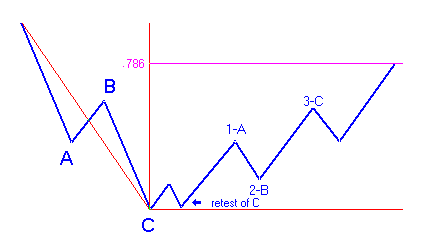
Gartley patterns happen most in a corrective
market. Elliott 5 wave patterns happen most in Impulsive
markets. This is how we have been going up since the low of
2003, Gartley after Gartley, because the market, although is going
up, is in a bear trend. Yes it is.
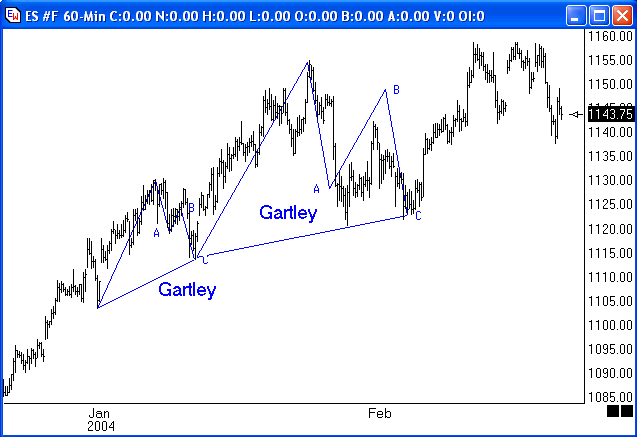
How do I trade? Here are two days that are
a perfect example of the mix between Elliott Wave patterns and
Gartley-Butterfly patterns. The market made a triangle, which
broke to the downside in a beautiful five wave
structure. All Fibonacci proportions fit.

A corrective pattern is developing on the right going
upward. This corrective pattern is forming a wedge, which is
more easily seen in the next image.

Do you need to know Fibonacci to do this?
Yes. Not only to know it, but to be able to draw targets very
fast once you get a sense of where you are within the unfolding
pattern.
Is Fibonacci enough? Not for me. Many
times Elliott doesn't give me precise entries and I need to go to a
lower time frame chart to look for a more precise entry with a small
stop loss. I also like it when I have other patterns that
confirm the five wave structure or the retracement pattern. I
watch for gaps, wedges, channels, etc.
The pattern being traded here is the Lower High (LH)
with divergence on the MACD study. HH stands for Higher
High. LL stands for Lower Low.
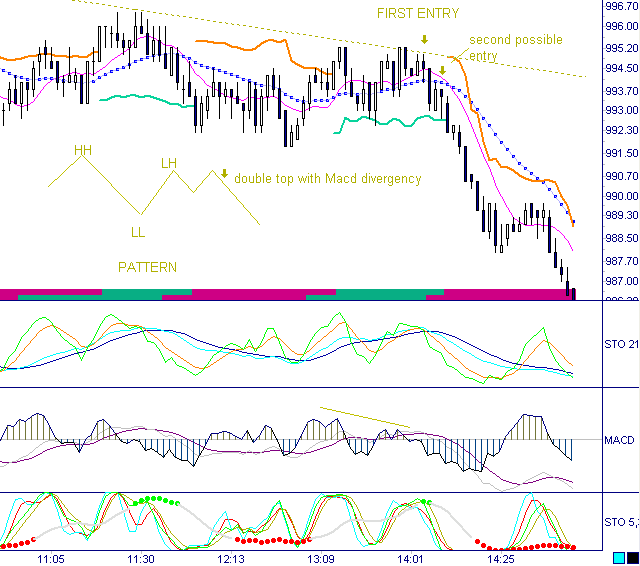
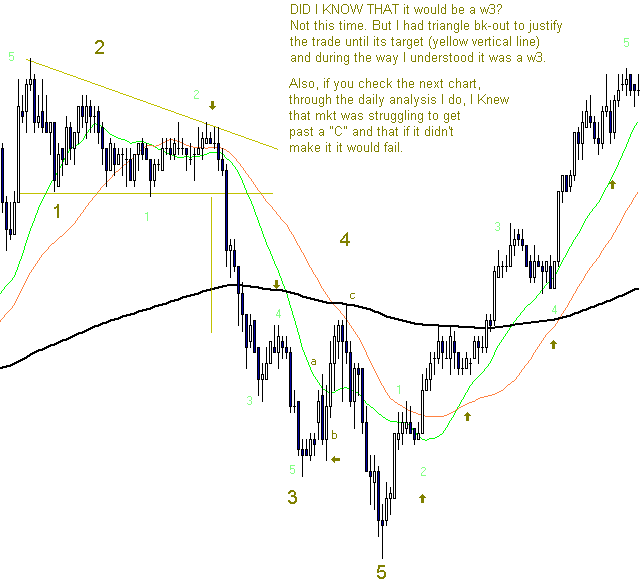
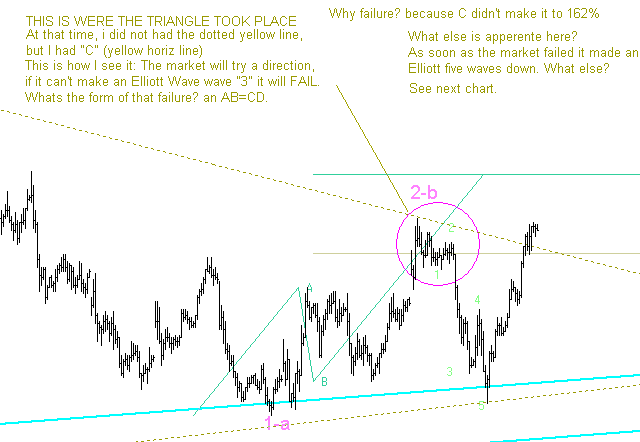
I had drawn the lower boundaries of a possible head
and shoulder. When the market did its five waves down I was
expecting it would break the neck with the 5th wave and give a nice
short opportunity. But it didn't. What did it do?
It failed, and what happened when it failed? It went up
like a bubble of air in the water. That's what failures of
patterns do. They change direction.
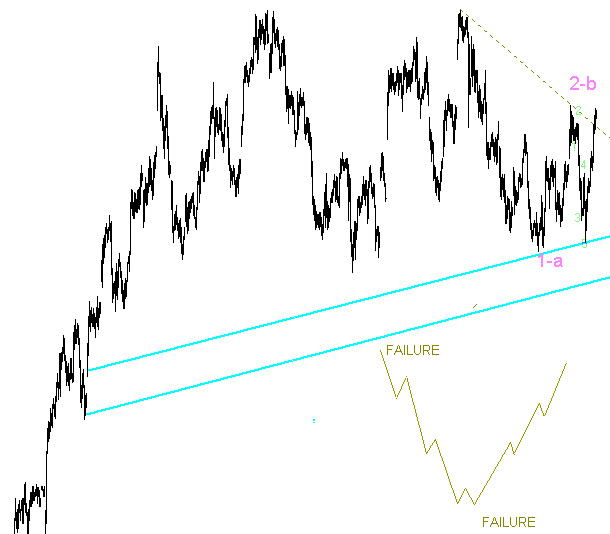
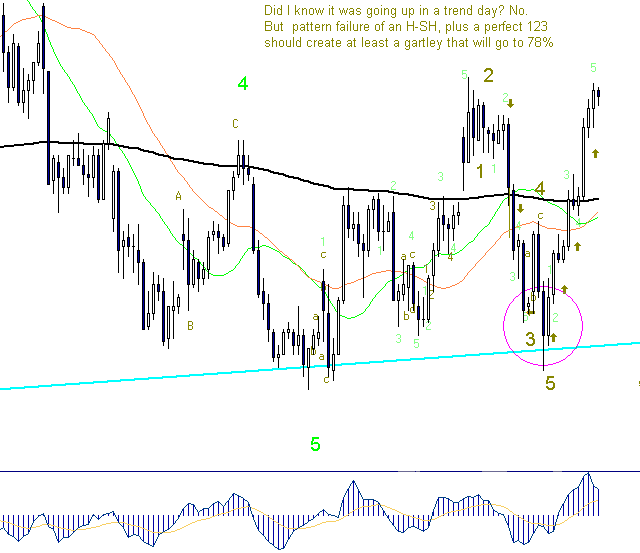
The formation marked with the circle was a perfect
1-2-3 lower bottom - or 2B with a nice MACD divergence to sustain
it.
All of this happens fast. You cannot pretend to
do this if you do not perfectly know proportions and the rules of at
least the patterns shown in this article. You also need
Ensign tools ready to do the work. Elliott Wave comes
slowly. First you learn the proportions and rules and then you
start recognizing the shape of waves and those shapes tell you about
counts, and counts will tell you about proportions.
Why not use ONLY Elliott Wave? Because the stops
are too wide. Why not use ONLY the entry systems based on
oscillators? Because I love the targets I get with Fibonacci
relationships. I also love Elliott Wave. I really like
the shapes. I like to guess when they appear. I like to
count the waves. I like the alternatives that Elliott Wave
theory gives about market movement.
(Editor's Note: Mary patronizes the B-Line
chat
room and frequently posts her excellent charts with current
Elliott Wave counts labeled to the http://www.dacharts.com/ web
site.) |